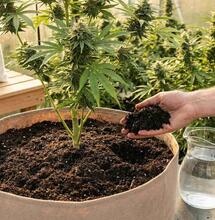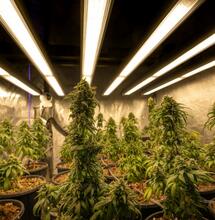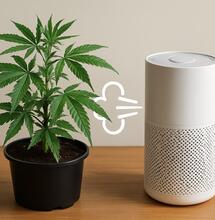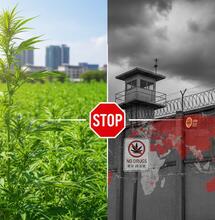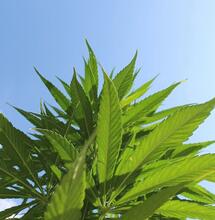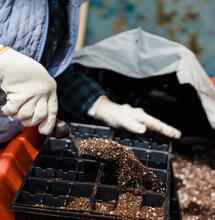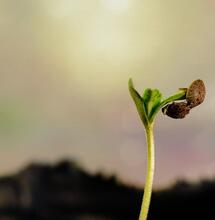Pre-harvest Watering of Cannabis Plants
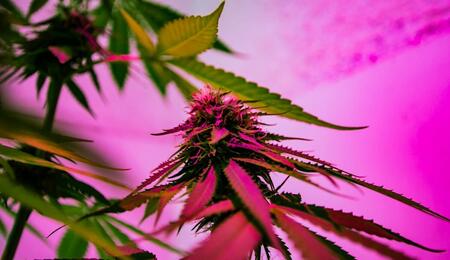
When the cannabis plants are flowering watering should be done regularly. Do a daily check-up on the soil moisture to make sure you aren’t overwatering. It is recommended to water in the morning so that the water can be used throughout the day. Soggy roots at night can slow growth significantly.
How and When to Water Cannabis Before Harvesting?
Watering should be stopped for a day or two before moving forward with cannabis harvest. The soil should stay dry, but not too dry so as to not trigger degeneration in plants. Avoiding watering in the last 24-48 hours of harvest will not affect the cannabinoids and terpenes. Rather, it will reduce drying time by a day or two.
Some growers want to keep the plants in complete darkness for those same 24-48 hours before harvesting. This practice is said to make buds more resinous. Combined with no-watering in the 1-2 days prior to chopping and hanging your plants, it should additionally promote resin production. Once again, just make sure the soil is not too dry; a lot depends on the local climate and whether you are growing indoors or outdoors.
How to Maintain Cannabis Fragrance and Terpenes During Harvest?
The smell of cannabis typically gets pretty intense in the time around harvest, both before and after. The odor will dominate the room where you hang the harvested plant material for drying. Therefore, to help control the pungent smell, there’s no need to remind you that the space where you dry and cure your buds needs to be well ventilated. Let in some fresh air to neutralize the smell; the temperature should also be controlled and not fall below 70°F (21°C).
Proper ventilation where you dry the harvested cannabis is also needed to preserve terpenes, the aromatic compounds that give the distinctive scent of marijuana; the specific smell will depend on which terpenes are most concentrated. Terpenes are important not only for smell; they act together with THC to deliver the full therapeutic effect of the strain.
Loss of cannabinoids and terpenes can happen during flowering, harvesting and storage. Exposure to high temperatures is one of the main culprits, but it can also be due to other types of negligence. The absence of terpenes (or cannabinoids) will not only affect the aromatic experience of weed, but the overall effect of the cannabis strain in question. This is why it is important to maintain a healthy environment for terpene progress.
What Can Cause Terpenes and Cannabinoids to Evaporate or Decay?
Flowering cannabis plants should not be exposed to harsh conditions, especially those in outdoor gardens. Think of rain, wind, or too much sunlight; a light cloth used as a shade can save the day in many instances. Shielding the plants from the elements of nature helps preserve the terpenes.
Attention should also be paid on contaminants, such as dust or bacteria, that may rack up on the foliage. Pollutants can trigger chemical reactions that speed up the decay of cannabinoids and terpenes, and they are more present in indoor settings rather than in the open. Indoors, the other great threat is excess heat from grow lights that are incorrectly positioned to the plant’s canopy.
Too much heat will cause the terpenes to dissipate, again resulting in plants losing their fragrance. The more heat there is, the greater the loss of terpenes. Extreme environments in general (it could also be too much humidity) as well as pests and diseases, create huge stress on the plants, and the first to suffer is terpenes, then cannabinoids.
The Importance of Ventilation
Excess water can lead to increased humidity because the molecules of water have nowhere to go but to transpire in the air surrounding the plants (this can also cause many other problems, including root disease).
Proper ventilation pre-harvest or post-harvest is essential to deal with stale or humid air, which can affect the quality of buds. Cannabis can lose its aromatic appeal if it is dried in too hot an environment or if the drying is hurried. When not properly dried, extra compounds like chlorophyll remain on the plant material, which does alter the taste and flavor of the buds as well. Dried poorly, there are greater chances for the buds to retain excess moisture. This is a recipe for disease, most certainly accompanied by an unpleasant smell. It won’t go unnoticed during smoking and consumption.
Washing Cannabis Roots Pre-harvest
In preparations for harvest, it is recommended that the soil is thoroughly washed with clean water solution or reverse osmosis water. It can be done a week before harvest, and it will help neutralize fertilizer leftovers that may have accumulated in the grow medium. Washing with water or a rinsing solution will help you avoid the chemical or organic fertilizer taste of harvested buds.
There are indoor gardeners who fertilize with a salt-based liquid fertilizer up to 2-3 days before harvest, and use a rinsing solution to remove fertilizer residue. This practice is said to help the plants retain weight in the flowering buds. However, this does not make the buds develop faster, and fertilizer residues are still present in the plant tissue. The point is that fertilizer adds weight at the expense of medicinal quality. Apply the washing solution according to the instructions. Always allow at least 10%, preferably more, to drain out of the containers.
Brittle leaves upon harvest, burnt tips and leaf margins, and chemical-like smell of buds are some of the common signs that the buds have been affected by the fertilizer.
Making Sure You Don’t Miss Pests and Diseases Before Harvest
Inspecting plants at night with a green light, UV-B or UV-C lamp, makes it impossible to miss pests and diseases. Powdery mildew and pest droppings and traces are visible on the light spectrum emitted by these types of lamps. If you detect any, carefully remove all signs of powdery mildew before it penetrates the plant tissue. Spray the fungus with an organic fungicide before washing to ensure that it does not contaminate the rest of the crop. However, this method only works when there is very little powdery mildew.
More from Soft Secrets:
